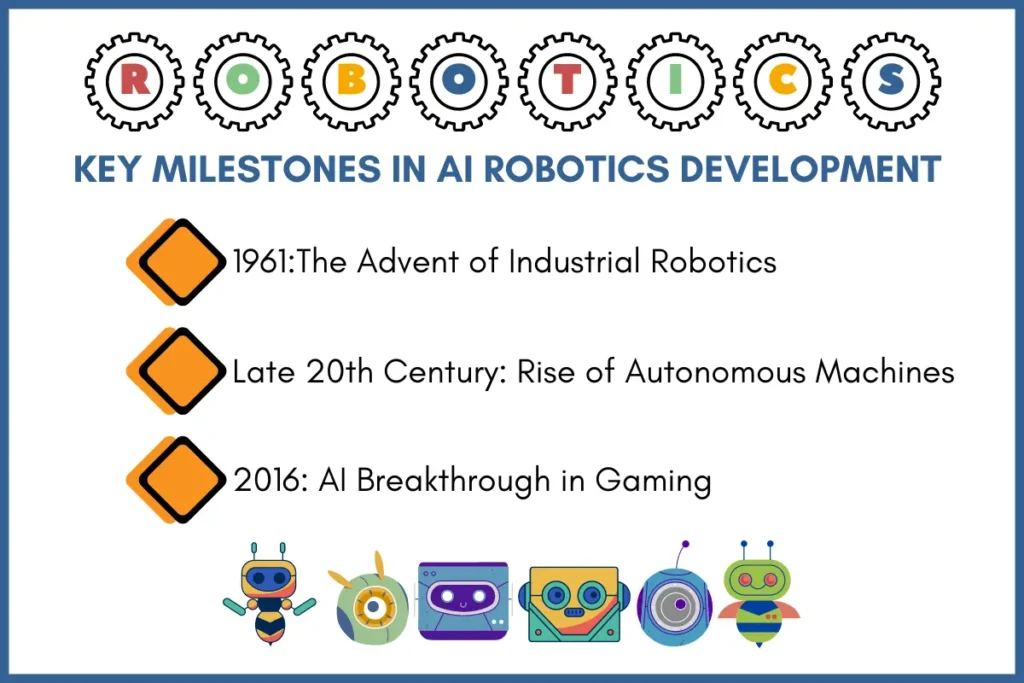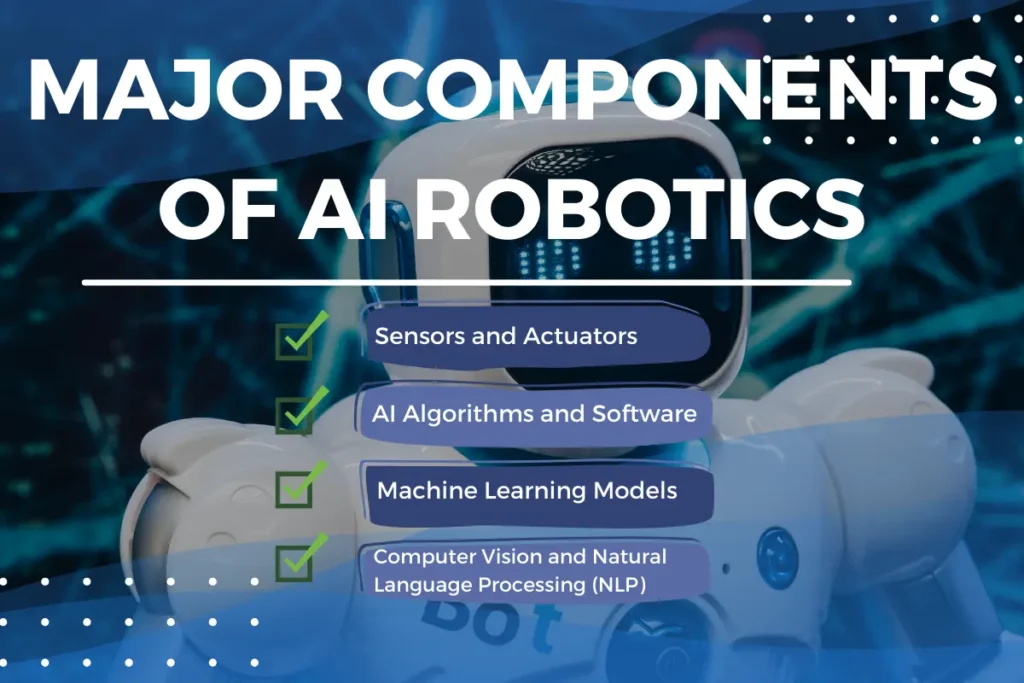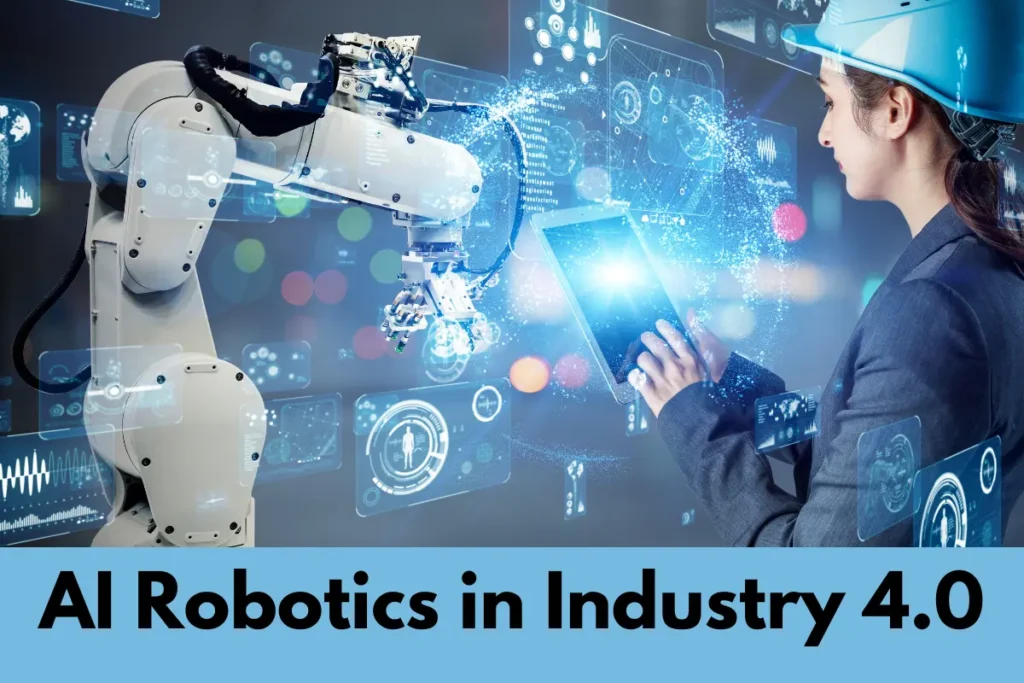
AI Robotics: The Confluence of Cutting-Edge Technologies
Shoumya Chowdhury
Artificial Intelligence (AI) and robotics are reshaping modern industries, pushing the boundaries of what machines can autonomously accomplish. The fusion of these two revolutionary technologies, known as AI robotics, is transforming industrial automation and extending into sectors like healthcare, agriculture, and space exploration. With a global push toward more intelligent, efficient, and adaptive systems, AI robotics holds the potential to redefine how society interacts with machines.
This comprehensive guide delves into the heart of AI robotics, exploring its applications, key components, and future outlook. Drawing insights from leading experts and research publications, we provide a detailed exploration of how AI and robotics combine to create intelligent systems capable of performing complex tasks with minimal human intervention. We also address ethical concerns, technical challenges, and the role of AI robotics in shaping Industry 4.0.
As we advance further into the 21st century, the evolution of AI robotics is poised to push the boundaries of machine capabilities, influencing both industrial processes and daily life.
Key Milestones in AI Robotics Development

The evolution of AI robotics is marked by significant milestones that have shaped the current landscape of intelligent machines. From simple mechanical devices to fully autonomous systems, these key developments highlight how AI has enhanced robotics over the decades:
1961: The Advent of Industrial Robotics
The introduction of the first industrial robot, Unimate, revolutionized assembly line production. This early robot demonstrated the potential for automating repetitive tasks, laying the groundwork for further advancements in industrial automation.
Late 20th Century: Rise of Autonomous Machines
The development of autonomous robots during the late 20th century set the stage for intelligent systems capable of operating without direct human control. As AI technologies matured, robots transitioned from simple mechanical arms to fully independent machines capable of decision-making.
2016: AI Breakthrough in Gaming
A major leap in AI robotics occurred when Google’s AlphaGo defeated world champions in the game of Go. This event demonstrated AI’s ability to process complex information and learn from its environment, a crucial aspect of modern robotics and machine learning in robotics.
Each of these milestones has contributed to the sophisticated AI robotics systems we see today, enabling robots to perform tasks autonomously, learn from data, and interact intelligently with their surroundings.
Major Components of AI Robotics

AI robotics is built on several key components, each contributing to the intelligent, autonomous functioning of these machines. Understanding these elements is crucial to grasp how AI enhances robotics to solve complex tasks.
1. Sensors and Actuators
Sensors and actuators are the core elements that allow robots to perceive and interact with their environment.
- Sensors gather data from the surroundings—such as light, temperature, or pressure—enabling robots to detect changes.
- Actuators convert electrical signals into physical motion, allowing the robot to execute tasks based on sensor inputs.
2. AI Algorithms and Software
The decision-making capability of AI robotics relies heavily on sophisticated algorithms.
- Artificial Intelligence algorithms enable robots to learn, adapt, and respond to stimuli by processing large amounts of data.
- Machine Learning (ML) and neural networks are integral, allowing robots to improve performance over time through self-learning and pattern recognition.
3. Machine Learning Models
Machine Learning models enable robots to analyze data and improve their tasks based on experience.
- Robots can identify patterns, predict outcomes, and adjust their behavior accordingly.
- In manufacturing plants, ML-powered robots enhance operational efficiency by learning from past data.
4. Computer Vision and Natural Language Processing (NLP)
- Computer Vision allows robots to “see” by interpreting visual data from the environment.
- Natural Language Processing (NLP) equips robots with the ability to understand and respond to human commands.
Together, these technologies enable AI robots to interact more naturally with humans, performing tasks like object recognition, navigation, and speech comprehension.
These components, when integrated, make AI robotics a versatile technology capable of functioning autonomously across diverse environments.
Applications of AI Robotics Across Industries

AI robotics has become a transformative force across multiple industries, automating tasks that were once labor-intensive, dangerous, or difficult for humans to perform. Here’s how AI-powered robots are making significant strides in various sectors:
1. Industrial Automation
AI-powered robots are revolutionizing industries such as manufacturing, logistics, and warehousing.
- Perform repetitive and hazardous tasks with high precision and speed.
- Optimize workflows, increase production efficiency, and reduce human error by analyzing data in real-time.
- Example: Robots in assembly lines adapt and improve operations, enhancing operational efficiency.
2. Healthcare and Surgical Robotics
In the healthcare sector, robots equipped with AI assist in performing surgeries, allowing for greater precision and minimizing the risk of human error.
- Robots like the da Vinci Surgical System provide surgeons with enhanced dexterity and control.
- AI-driven robots assist in elderly care, rehabilitation, and daily tasks, improving patient outcomes and quality of life.
3. Agriculture
AI robotics is transforming agriculture by automating processes like planting, harvesting, and crop monitoring.
- AI-powered drones and ground robots analyze soil conditions, identify pests, and predict crop yields.
- Real-time data analysis helps optimize resource use and increase efficiency, leading to sustainable farming practices.
4. Space Exploration
NASA and other space agencies rely on AI-driven robots for space exploration missions.
- Robots navigate harsh extraterrestrial environments, collect data, and repair spacecraft autonomously.
- The Mars rover Curiosity exemplifies how AI robotics allows exploration of environments where humans cannot easily operate.
5. Autonomous Vehicles
AI robotics is a key driver behind the development of autonomous vehicles.
- Self-driving cars and drones use machine learning algorithms and computer vision to navigate, avoid obstacles, and make real-time decisions.
- Potential to revolutionize transportation and logistics by reducing accidents and optimizing delivery routes.
6. Service Robots in Everyday Life
Service robots have become a common part of daily life, helping with household chores, security, and even providing companionship.
- Robotic vacuum cleaners like Roomba simplify cleaning tasks.
- AI personal assistants improve convenience in homes and workplaces.
These diverse applications demonstrate the far-reaching impact of AI robotics on various sectors, paving the way for a more efficient and automated future.
The Role of Machine Learning in Robotics

Machine Learning (ML) plays a pivotal role in advancing the capabilities of AI-powered robots. ML enables robots to identify patterns, predict outcomes, and learn from their environment, improving their performance over time without human intervention. This self-learning ability allows robots to become more adaptive and efficient as they perform tasks in various industries.
Core Functions of Machine Learning in Robotics
- Data Analysis: ML algorithms analyze vast amounts of data to detect trends and make informed decisions.
- Continuous Improvement: Robots optimize their operations by learning from previous tasks and adjusting accordingly.
- Autonomous Decision-Making: Enables robots to handle unexpected situations by adapting their behavior in real-time.
Computer Vision and NLP in Robotics
- Computer Vision: Allows robots to interpret visual data, crucial for tasks like object recognition and navigation.
- Natural Language Processing (NLP): Empowers robots to understand and respond to human commands, enhancing human-robot interaction.
As AI and ML continue to evolve, robots will increasingly leverage these technologies to enhance their decision-making processes and achieve higher levels of autonomy.
Challenges in AI Robotics Development

Despite rapid advancements, several challenges hinder the development and widespread adoption of AI robotics. These challenges are both technical and ethical, affecting how AI-powered robots integrate into real-world environments.
Technical Limitations
Unpredictable Environments
- Complex Environments: Robots struggle in dynamic spaces like crowded urban streets or disaster zones.
- Real-Time Processing: Difficulty in processing vast amounts of sensory data in real-time to make adaptive decisions.
Data Requirements
- Large Datasets: Need for high-quality data to train machine learning models.
- Privacy and Safety Concerns: Acquiring data in industries like healthcare or autonomous driving can be challenging.
Ethical Concerns and Potential Risks
Job Displacement
- Automation Threat: Potential to replace human jobs, leading to unemployment in sectors like manufacturing and logistics.
Privacy and Security
- Data Collection: AI robots raise concerns due to the data they collect and the decisions they make autonomously.
- Surveillance Risks: Potential for unauthorized surveillance and data misuse.
Moral Responsibility
- Decision-Making: Challenges in developing AI systems capable of making ethical decisions.
- Accountability: Determining who is responsible when AI robots make mistakes or cause harm.
These challenges underscore the need for continuous research, development, and collaboration between technologists, ethicists, and policymakers to ensure AI robotics evolves in a way that benefits humanity while mitigating risks.
Ethical Considerations and Risks in AI Robotics

As AI robotics becomes more integrated into our daily lives and industries, ethical considerations come to the forefront. The development and deployment of AI systems raise several ethical concerns, from data privacy to moral responsibility and job displacement.
Data Privacy and Surveillance
- Infringing Privacy Rights: Risk of unauthorized surveillance due to data collection capabilities of AI robots.
- Data Control: Concerns about who controls the data, how it is used, and potential breaches of confidentiality.
Job Displacement and Economic Disparity
- Automation Impact: Threat to jobs, particularly in sectors like manufacturing and logistics.
- Economic Inequality: Potential for increased economic disparity and social upheaval due to widespread automation.
Moral Responsibility and Accountability
- Decision Accountability: Complexity in determining who is responsible for decisions made by AI-powered robots.
- Black Box Problem: Difficulty in explaining the reasoning behind a robot’s actions due to opaque AI decision-making processes.
Bias and Discrimination
- Inherited Biases: AI systems can inherit biases present in training data.
- Unfair Treatment: Potential for discrimination in areas like hiring, law enforcement, and lending.
These ethical considerations highlight the importance of developing AI robotics in a manner that is transparent, fair, and accountable. Ongoing debates among technologists, ethicists, and policymakers are crucial to ensuring the ethical deployment of AI robotics.
The Future of AI Robotics

The future of AI robotics holds immense potential as advancements continue to accelerate across multiple industries. Over the next decade, we can expect AI robotics to evolve in ways that were once confined to science fiction.
Human-Robot Collaboration
- Collaborative Robots (Cobots): Designed to work alongside humans, assisting in tasks that require precision or repetitive actions.
- Enhanced Capabilities: Cobots will become more intuitive, capable of learning and adapting to human behaviors, and responsive to emotions.
Emotional Intelligence in Robots
- Understanding Emotions: Robots will analyze facial expressions, voice tones, and body language to tailor interactions.
- Applications: Could provide companionship, assist in mental health treatments, and offer personalized customer service.
Autonomous Decision-Making
- Complex Decisions: Future robots will make complex decisions in real time, handling unpredictable environments.
- Ethical Choices: Capable of making ethical decisions, collaborating effectively with other machines and humans.
AI Robotics in Industry 4.0
- Smart Factories: AI robots will optimize production by reducing waste, improving efficiency, and ensuring consistent product quality.
- Supply Chain Management: Streamlining processes, enabling companies to respond to market demands in real time.
Challenges Ahead
- Technical Hurdles: Building truly autonomous systems capable of thriving in unpredictable environments.
- Ethical Concerns: Addressing job displacement, privacy issues, and the ethical implications of autonomous decision-making.
- Societal Impacts: Managing the societal impacts of widespread automation.
A Promising Horizon
As technology continues to evolve, the future of AI robotics looks incredibly promising. By embracing these technologies responsibly, society can unlock new levels of productivity, creativity, and human-machine collaboration.
AI Robotics in Industry 4.0

AI robotics plays a crucial role in shaping the future of Industry 4.0, marking the integration of smart technologies into manufacturing and industrial processes.
AI Robotics in Smart Factories
- Integration: Robots and AI-driven machines interact with each other and with humans to streamline production processes.
- Cobots: Robots handle repetitive or dangerous tasks, allowing human workers to focus on decision-making and creativity.
Supply Chain Optimization
- Autonomous Robots: Used to transport goods, sort products, and manage inventory in warehouses.
- Predictive Analytics: AI forecasts demand, optimizes routes, and manages inventory more effectively.
Real-Time Monitoring and Adaptation
- Adaptive Systems: Robots monitor their environment, analyzing data to make real-time adjustments.
- Optimal Performance: Ensures efficiency and reduces operational risks.
The Road Ahead
- Data Security: Need for improved data security measures.
- Ethical Considerations: Addressing job displacement and managing complex AI systems.
- Innovation Driver: AI robotics will drive innovation, efficiency, and competitiveness across industries.
Conclusion: The Transformative Potential of AI Robotics
AI robotics is reshaping the future of industries, services, and daily life in unprecedented ways. By combining artificial intelligence with autonomous machines, this technology promises greater efficiency, adaptability, and intelligence in performing complex tasks.
However, as AI robotics continues to evolve, it brings forth challenges that must be addressed:
- Ethical Concerns: Job displacement, privacy, and decision-making responsibility require careful consideration.
- Technical Hurdles: Building autonomous systems capable of thriving in unpredictable environments.
Looking ahead, the future of AI robotics is bright. Innovations in emotional intelligence, machine learning, and human collaboration are driving the field forward. As intelligent systems become more integrated into our lives, their ability to enhance human capabilities will redefine our relationship with technology.
By embracing AI robotics responsibly and continuing to innovate, society stands to benefit from a more efficient, safer, and intelligent world where humans and robots collaborate in harmony.

Shoumya Chowdhury
Blogger and Web Developer
Shoumya Chowdhury, an EEE graduate from CUET, is currently working as a web developer. Apart from his career, Shoumya is enthusiastic about blogging, sharing well-researched content on diverse topics. He is committed to providing authentic information and values the opportunity to engage with readers through his writing.
Comments
No comments yet.

